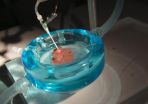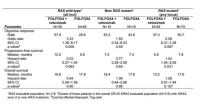(Press-News.org) Researchers have developed a new supercooling technique to increase the amount of time human organs could remain viable outside the body. This study was conducted in rats, and if it succeeds in humans, it would enable a world-wide allocation of donor organs, saving more lives.
The research is supported by National Institute of Biomedical Imaging and Bioengineering (NIBIB) and the National Institute of Diabetes and Digestive and Kidney Disease (NIDDK), both parts of the National Institutes of Health.
The first human whole organ transplant 60 years ago—a living kidney transplant—changed the landscape of the medical world. Since then, transplants of skin, kidneys, hearts, lungs, corneas, and livers have become commonplace but due to a shortage of donor organs, more than 120,000 patients are still on waitlists for organ transplantation in the United States alone.
Current technology can preserve livers outside the body for a maximum of 24 hours using a combination of cold temperatures and a chemical solution developed by scientists at the University of Wisconsin-Madison in 1983. The solution helps keep the liver tissue from dying while in transit to the recipient site. This has helped increase the number of successful liver transplants—but extending even further the time a liver can survive outside the body would provide many benefits. It would allow for more time to prepare the patient and ease logistics at the donor hospital site, reduce the urgency of rushing the organ to its destination, and expand the donation area to allow for transcontinental and intercontinental transplantations—thus increasing the chances of patients finding better matches while simultaneously significantly reducing costs.
The difficulty with long-term preservation of human organs stems mostly from the extensive tissue damage that occurs when organs are cryopreserved, frozen at temperatures of -320.8 degrees Fahrenheit. While successful for single cells and simple tissues, the problem is exacerbated with whole organs because of the multiple cell types and other structures that react differently to cold. To combat these problems, Martin Yarmush, M.D., Ph.D., and Korkut Uygun, Ph.D., investigators in the Center for Engineering in Medicine at Massachusetts General Hospital (MGH), Boston, have developed a four-step preservation technique that has tripled the amount of time that rat livers can be stored before transplantation.
In the June 29 online issue of Nature Medicine, the researchers describe their process. The first step is to employ the use of machine perfusion—a way of delivering oxygen and nutrients to capillaries in biological tissues while outside the body—to supercool the liver tissue without causing irreversible damage to the cells. In order to accomplish this, the MGH team added 3-OMG (3-O-methyl-D-glucose), a non-toxic, modified glucose compound, to the solution being delivered to the liver. The 3-OMG is taken up and because it cannot be metabolized by cells, accumulates in the hepatocytes (liver cells), acting as a protectant against the cold. The team also modified the solution by adding PEG-35kD (polyethylene glycol) to specifically protect cell membranes. Ethylene glycol is the active ingredient in anti-freeze, and it works by lowering the freezing point of a solution.
The livers were then slowly cooled below the freezing point, to 21 degrees Fahrenheit, without inducing freezing—thereby supercooling the organ for preservation. After storing the organs for several days, the researchers again used machine perfusion to rewarm the organ, while also delivering oxygen and other nutrients to prepare the organ for transplantation.
Using this new technique, the researchers were able to store the supercooled rat livers for three days (72 hours) and four days (96 hours) at 21 degrees Fahrenheit. All the rats who had supercooled livers stored for three days survived three months, but none of the rats who had transplants using current methods did. The survival rate for animals receiving livers stored for four days was 58 percent. When testing to see if all the steps in their method were essential, the researchers found that if they eliminated the supplemental components PEG-35kD or 3-OMG, none of the rats survived for even a week. If they did not use machine perfusion or supercooling, death occurred within an hour of transplantation.
"The next step will be to conduct similar studies in larger animals," said Rosemarie Hunziker, Ph.D., program director of Tissue Engineering and Regenerative Medicine at NIBIB. "It is exciting to see such an achievement in small animals, by recombining and optimizing existing technology. The main point here is that using all of these approaches at once was what led to success. Halfway measures did not do. Such a tour de force reflects this team's very deep understanding of the complex processes at work here, and how they relate simultaneously to each other."
The process must go through extensive testing and refinement before it could be considered for use in humans. But the technique's achievement in being the first method to have a successful survival rate after the livers had been stored for three days and possible potential for four-day storage has broad implications for the future of liver transplantation.
"The longer we are able to store donated organs, the better the chance the patient will find the best match possible, with both doctors and patients fully prepared for surgery," said Hunziker. "This is a critically important step in advancing the practice of organ storage for transplantation."
INFORMATION:
Among the researchers contributing to this project are Tim Berendsen, M.D., who performed the transplants, and Bote Bruinsma, an M.D., PhD. student at University of Amsterdam conducting his graduate studies with Drs. Yarmush and Uygun. The team was comprised of 10 engineers, scientists and surgeons at the Center for Engineering in Medicine at the Massachusetts General Hospital/Harvard Medical School, Boston.
This work was supported by NIH's National Institute of Biomedical Imaging and Bioengineering and the National Institute of Diabetes and Digestive and Kidney Disease under award numbers R01EB008678, R01DK096075, R00DK080942, R00DK088962; the authors also gratefully acknowledge Shriners Hospitals for Children.
NIBIB's mission is to improve health by leading the development and accelerating the application of biomedical technologies. The Institute is committed to integrating the physical and engineering sciences with the life sciences to advance basic research and medical care. NIBIB supports emerging technology research and development within its internal laboratories and through grants, collaborations, and training. More information is available at the NIBIB website: http://www.nibib.nih.gov.
The NIDDK, a component of the NIH, conducts and supports research on diabetes and other endocrine and metabolic diseases; digestive diseases, nutrition and obesity; and kidney, urologic and hematologic diseases. Spanning the full spectrum of medicine and afflicting people of all ages and ethnic groups, these diseases encompass some of the most common, severe and disabling conditions affecting Americans. For more information about the NIDDK and its programs, see http://www.niddk.nih.gov.
The National Institutes of Health, the nation's medical research agency, includes 27 Institutes and Centers and is a component of the U.S. Department of Health and Human Services. NIH is the primary federal agency conducting and supporting basic, clinical, and translational medical research, and is investigating the causes, treatments, and cures for both common and rare diseases. For more information about NIH and its programs, visit http://www.nih.gov.
NIH-funded researchers extend liver preservation for transplantation
Livers successfully stored for three days in animal study
2014-06-29
ELSE PRESS RELEASES FROM THIS DATE:
Massachusetts General-developed protocol could greatly extend preservation of donor livers
2014-06-29
A system developed by investigators at the Massachusetts General Hospital (MGH) Center for Engineering in Medicine allowed successful transplantation of rat livers after preservation for as long as four days, more than tripling the length of time organs currently can be preserved. The team describes their protocol – which combines below-freezing temperatures with the use of two protective solutions and machine perfusion of the organ – in a Nature Medicine paper receiving advance online publication.
"To our knowledge, this is the longest preservation time with subsequent ...
Reconstructing the life history of a single cell
2014-06-29
Researchers have developed new methods to trace the life history of individual cells back to their origins in the fertilised egg. By looking at the copy of the human genome present in healthy cells, they were able to build a picture of each cell's development from the early embryo on its journey to become part of an adult organ.
During the life of an individual, all cells in the body develop mutations, known as somatic mutations, which are not inherited from parents or passed on to offspring. These somatic mutations carry a coded record of the lifetime experiences of ...
Study finds Emperor penguin in peril
2014-06-29
An international team of scientists studying Emperor penguin populations across Antarctica finds the iconic animals in danger of dramatic declines by the end of the century due to climate change. Their study, published today in Nature Climate Change, finds the Emperor penguin "fully deserving of endangered status due to climate change."
The Emperor penguin is currently under consideration for inclusion under the US Endangered Species Act. Criteria to classify species by their extinction risk are based on the global population dynamics.
The study was conducted by lead ...
Noninvasive brain control
2014-06-29
CAMBRIDGE, MA -- Optogenetics, a technology that allows scientists to control brain activity by shining light on neurons, relies on light-sensitive proteins that can suppress or stimulate electrical signals within cells. This technique requires a light source to be implanted in the brain, where it can reach the cells to be controlled.
MIT engineers have now developed the first light-sensitive molecule that enables neurons to be silenced noninvasively, using a light source outside the skull. This makes it possible to do long-term studies without an implanted light source. ...
Bending the rules
2014-06-29
(Santa Barbara, Calif.) — For his doctoral dissertation in the Goldman Superconductivity Research Group at the University of Minnesota, Yu Chen, now a postdoctoral researcher at UC Santa Barbara, developed a novel way to fabricate superconducting nanocircuitry. However, the extremely small zinc nanowires he designed did some unexpected — and sort of funky — things.
Chen, along with his thesis adviser, Allen M. Goldman, and theoretical physicist Alex Kamenev, both of the University of Minnesota, spent years seeking an explanation for these extremely puzzling effects. ...
Improved method for isotope enrichment could secure a vital global commodity
2014-06-29
AUSTIN, Texas — Researchers at The University of Texas at Austin have devised a new method for enriching a group of the world's most expensive chemical commodities, stable isotopes, which are vital to medical imaging and nuclear power, as reported this week in the journal Nature Physics. For many isotopes, the new method is cheaper than existing methods. For others, it is more environmentally friendly.
A less expensive, domestic source of stable isotopes could ensure continuation of current applications while opening up opportunities for new medical therapies and fundamental ...
Improved survival with TAS-102 in mets colorectal cancer refractory to standard therapies
2014-06-28
The new combination agent TAS-102 is able to improve overall survival compared to placebo in patients whose metastatic colorectal cancer is refractory to standard therapies, researchers said at the ESMO 16th World Congress on Gastrointestinal Cancer in Barcelona.
"Around 50% of patients with colorectal cancer develop metastases but eventually many of them do not respond to standard therapies," said Takayuki Yoshino of the National Cancer Centre Hospital East in Chiba, Japan, lead author of the phase III RECOURSE trial. "The RECOURSE study shows that TAS-102 improves overall ...
Cetuximab or bevacizumab with combi chemo equivalent in KRAS wild-type MCRC
2014-06-28
For patients with KRAS wild-type untreated colorectal cancer, adding cetuximab or bevacizumab to combination chemotherapy offers equivalent survival, researchers said at the ESMO 16th World Congress on Gastrointestinal Cancer in Barcelona.
"The CALGB/SWOG 80405 trial was designed and formulated in 2005, and the rationale was simple: we had new drugs --bevacizumab and cetuximab-- and the study was designed to determine if one was better than the other in first-line for patients with colon cancer," said lead study author Alan P. Venook, distinguished Professor of Medical ...
Herpes virus infection drives HIV infection among non-injecting drug users in New York
2014-06-27
HIV and its transmission has long been associated with injecting drug use, where hypodermic syringes are used to administer illicit drugs. Now, a newly reported study by researchers affiliated with New York University's Center for Drug Use and HIV Research (CDUHR) in the journal PLOS ONE, shows that HIV infection among heterosexual non-injecting drug users (no hypodermic syringe is used; drugs are taken orally or nasally) in New York City (NYC) has now surpassed HIV infection among persons who inject drugs.
The study, "HSV-2 Co-Infection as a Driver of HIV Transmission ...
Potential Alzheimer's drug prevents abnormal blood clots in the brain
2014-06-27
Without a steady supply of blood, neurons can't work. That's why one of the culprits behind Alzheimer's disease is believed to be the persistent blood clots that often form in the brains of Alzheimer's patients, contributing to the condition's hallmark memory loss, confusion and cognitive decline.
New experiments in Sidney Strickland's Laboratory of Neurobiology and Genetics at Rockefeller University have identified a compound that might halt the progression of Alzheimer's by interfering with the role amyloid-β, a small protein that forms plaques in Alzheimer's brains, ...
LAST 30 PRESS RELEASES:
School meals could unlock major gains for human and planetary health
Menopause hormone therapy does not appear to impact dementia risk
Signature patterns of brain activity may help predict recovery from traumatic brain injury
Dresden study uncovers new key mechanism in cancer cells
New species are now being discovered faster than ever before, study suggests
Cannabis-based products show limited short-term benefit for chronic pain, with increased risk of adverse effects
Cannabis products with more THC slightly reduce pain but cause more side effects
Clearing the brain of aging cells could aid epilepsy and reduce seizures
Brain injuries linked with potential risk of suicide, new study finds
New technique lights up where drugs go in the body, cell by cell
New study finds movement of fishing fleets can reveal shifts in marine ecosystems
Embargoed: New evidence points to potential treatment for vascular dementia
Study uncovers disrupted brain balance in alcohol dependence
Working in groups can help Republicans and Democrats agree on controversial content moderation online
Structural findings reveal how distinct GPCR ligands create different levels of activation
Anything-goes “anyons” may be at the root of surprising quantum experiments
UC review: Maximizing workplace opportunity for veterans
From generation to complex control: Metasurfaces make perfect vortex beams "within reach"
Thin-film lithium niobate-based detector: recent advances and perspectives
Exploring why some people may tend to persistently make bad choices
How cells balance their protein levels
Nirsevimab vs RSVpreF vaccine for RSV–related hospitalization in newborns
Effectiveness and impact of maternal RSV immunization and nirsevimab on medically attended RSV in US children
AI gives scientists a boost, but at the cost of too many mediocre papers
Next-generation vision model maps tree growth at sub-meter precision
Genes aren’t destiny for inherited blindness, study shows
MIT study: High-fat diets make liver cells more likely to become cancerous
Exposure to multiple fine particulate matter components and incident depression in the US Medicare population
Risk of burdensome health care spending over time in the US
Nirsevimab against hospitalizations and emergency department visits for lower respiratory tract infection in infants
[Press-News.org] NIH-funded researchers extend liver preservation for transplantationLivers successfully stored for three days in animal study






